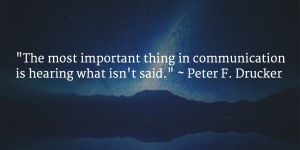Investigation Interviewing: 3 Tips to Improve Non-Verbal Communication

Non-verbal communication (body language) is significant because it reveals how we feel (sometimes in spite of what we say), and it also reveals how other people feel about us. Most of us are not formally trained in non-verbal behaviors but living in the world has taught us many non-verbal cues informally.
For example, have you ever met someone and felt like you didn’t like them but couldn’t pinpoint why? They may have thrown off negative non-verbal cues that you picked up subconsciously, and that is why you stepped away from the experience feeling like you didn’t like the person. You probably know more than you think you do about non-verbal communication from both positive and negative life experiences, and putting the pieces together will help you become a better communicator and interviewer.
At the Global TapRooT® Summit I’ve shared best practices for decoding non-verbal behavior which is particularly helpful in incident investigative interviews. I also taught this subject in our Interviewing & Basic Investigation course. When interviewing others after an accident or incident, it’s very important to gain the interviewee’s confidence and trust to put them at ease, and help them remember important details.
Today I’d like to share three quick tips on how to improve non-verbal communication that will improve your interviewing skills.
1. Lower your eyebrows. When we relax tension in our faces, the rest of the body follows in relaxation. Close your eyes right now and release the tension in the forehead and brows. Notice how the rest of your body becomes more relaxed. Practice this before your interviewee arrives and your relaxed body language will help your interviewee relax as well.
2. Palms up. When we talk we often gesture with our hands. Palms up sends a message that we have nothing to hide in our agenda, and also conveys that we are open to receiving what the interviewee says. Palms down indicates that we have closed our thinking – it may send a message of conviction – that your mind has been made up about what caused the accident.
3. Don’t overdo it on eye contact. Many people think that constant eye contact is important to communicate effectively, but it can be very intimidating for an interviewee. Make good eye contact but don’t stare. Make eye contact for shorter periods of time releasing your gaze occasionally. Gaze at the lower half of an interviewee’s face occasionally as opposed to looking him or her right in the eye.
Always check your body language during an interview. It is essential to helping interviewees feel confident. When they feel confident that they are being helpful by your non-verbal behavior (trust me, they will notice that more than the words you speak), they will provide more information to help you complete your investigation.
I am curious to know, do you pay attention to an interviewees non-verbals? If so, what non-verbal signals are you looking for?



